Nicholas Muller traversed 1,300 kilometers along the Irtysh river basin from the Russian border city of Omsk, Siberia through Northern Kazakhstan (Pavlodar, Aksu, Semey, Ust-Kamenogorsk) to the last town at the Kazakh-Chinese border (Buran).
A drop of water, having appeared in the glaciers of the Chinese Altai mountains, will see a lot on its northwestern path as it joins the Irtysh River. First, there are many artificial canals, oil refineries, and cotton fields on the Chinese side. After crossing the border with Kazakhstan, that drop of water will cross Zaisan, one of the oldest lakes in the world, the Bukhtarma Reservoir (the largest artificial reservoir), and the powerful Bukhtarma hydropower plant.
It will sweep through two more hydroelectric power stations and help them generate electricity. The drop will see heavy floods and flooded houses, pollution due to the extraction of heavy metals, the remains of a former shipping company, and a floodplain that no longer floods.
That drop of water will cross the border with Russia and see people who live waist-deep in the water, and people whose houses are on the river, but who do not have access to clean drinking water. Soon after, that drop of water will reach the unfinished Krasnogorsk hydroelectric complex and think about why it is needed here at all, and then, through a series of purification facilities, arrive into the glass of an Omsk official.
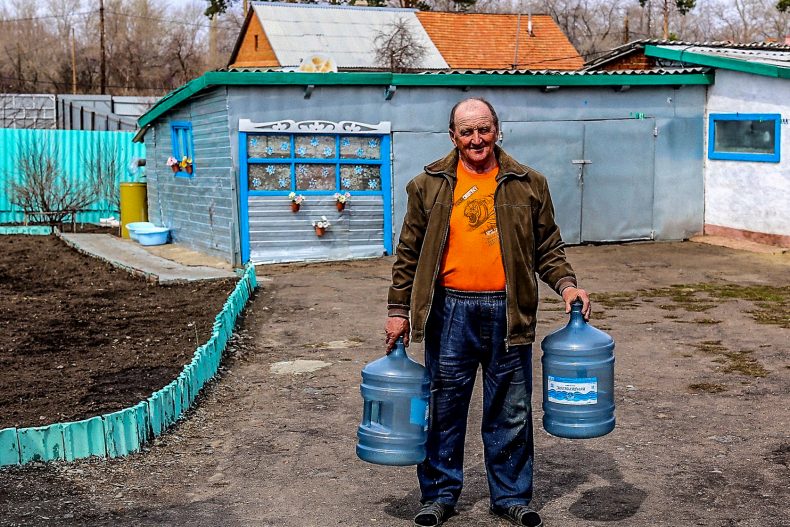
Vadim Ostapov says of his village, Trubetskoy in the Azov region of the Omsk region: “My village is 50 kilometers from the city, so it’s hard. Now I want to make myself a well; many do so.” Photo by Nicholas Muller.
Omsk: The Capital of the Irtysh
For Omsk, one of the largest and most important cities along the river, with a population of 1 million people, the Irtysh is the only source of drinking water. Today, many villages in the Omsk region continue to experience a lack of access to clean drinking water. Even if a village is on the river, the residents cannot safely take water from it. A special treatment process is necessary before the water is safe to drink. The only solution is to drill boreholes deeper.
“You have seen the water, haven’t you? One wouldn’t want to drink it – there is too much sand there. To be able to drink its water, one has to perform many treatments on it. Water treatment facilities in Omsk perform them but this process is expensive, which makes it impossible for small settlements,” says Omsk ecologist Sergey Kostarev.
One serious problem in this region is the quantitative aspect of contamination. Model simulations of water balance indicate that large industrial development in the spring area in China and continuously increasing water consumption in Kazakhstan may lead to desiccation — extreme drying — of the lower stretch of the river in Siberia during the summer months as soon as 2030.
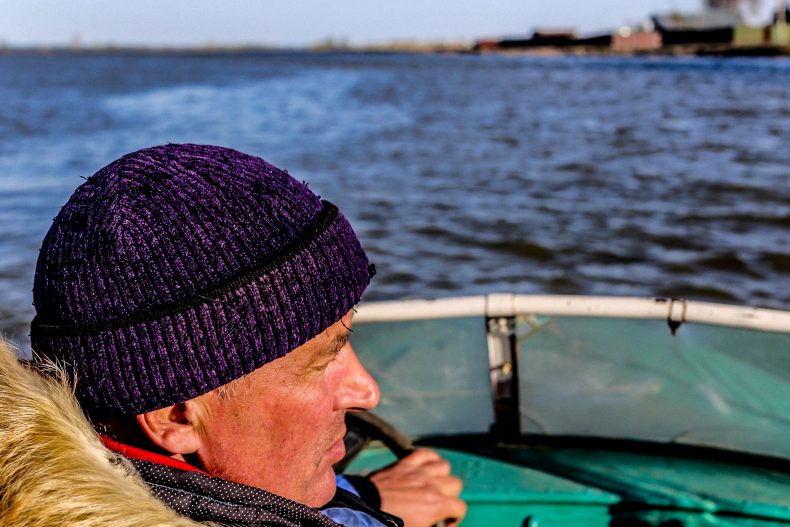
A local boatman from Aksu cruises along the river explaining the situation of the river; water level, fishing, boating, and contamination from a nearby local factory. Photo by Nicholas Muller
According to Kostarev, to reach unpolluted groundwater in the region a borehole needs to be between 80 and 100 meters deep. However, such drilling requires expensive equipment that neither residents nor private companies in Omsk have, so most people just dig wells 5 to 20 meters deep. Sure enough, water at that level is not suitable for drinking in most cases. One can only water the garden and wash with it.
“There is a lake nearby, but there is no clean water. Our pipeline is old. It was constructed back in the Soviet years,” Vadim Ostapov says about Trubetskoye, his village in the Azov district of the Omsk region. “My village is 50 kilometers away from the city, which makes it hard. Now I want to make a borehole on my land; many people do it.”
Ostapov says that it costs about 10,000 rubles (about $150) to dig a well. Digging a hole and installing a pump is quite easy and fast, while doing all paperwork takes much more time.
“Getting the permission takes the longest. You have to order expert evaluation to determine if the water is suitable for drinking or for irrigation. If it is for irrigation, then I cannot drink this water. Now you cannot ever construct a barn without paying some taxes. In other words, I get deceived on my own land,” sighs Ostapov.
“A friend of mine lives in Novinka village 20 kilometers away from the city. One day, we were driving from Omsk and he said: ‘Let’s stop by the water fountain and get some water.’”
Novinka stands on a salt marsh and there is no drinking water there at all. Water has to be delivered. A 200-liter barrel costs 50 rubles. They deliver it twice a week. For irrigation, people collect rainwater. “However, 50 rubles is a bit expensive, because when I buy water in cubic meters from the state, it comes out cheaper. If we talk about a babushka [old lady], where should she take money with a retirement allowance of 7,000 per month?” asks Ostapov.
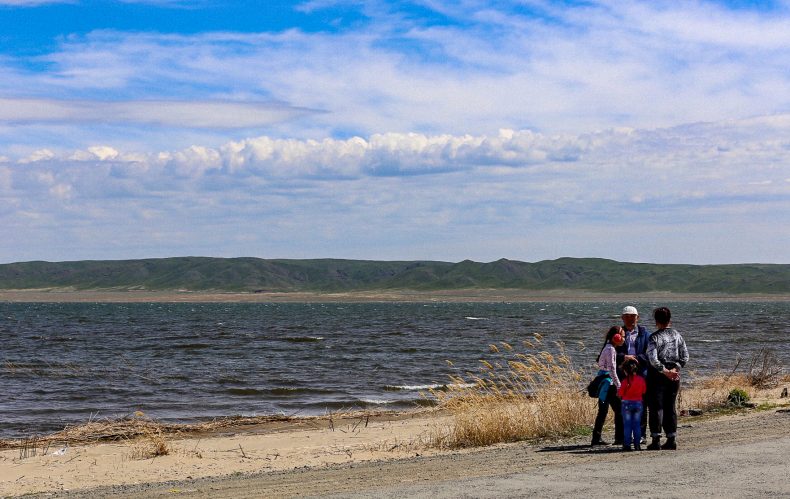
A family waiting to cross the Irtysh on the ferry waited for hours. The ferry company was privatized and has become unpredictable for people wanting to cross. Photo by Nicholas Muller
While Trubetskoye and Novinka are far from the river, Nizhny Irtysh in the Sargatsky district of the Omsk region is located just 2 kilometers away from the riverbank. However, the problem is similar – there is no drinking water. The water they have is plant water and one cannot drink it even after three-step filtration – it is yellow and has an unpleasant smell. The borehole for the water was dug during Soviet times when there was a large kolkhoz (collective farm) in Nizhny Irtysh. Residents assume that the waste from the kolkhoz polluted ground waters around the borehole.
Valentina Egorovna, 73, worked in the kolkhoz for over 30 years. She lives in a house together with her husband. Their children moved to the city a long time ago, but they visit every week to bring water. The retired woman allocated a whole storeroom for bottles of clean water. Plants and sprouts are in the next room. Egorovna waters them with clean water only. She says that the village residents don’t want to drink water from the borehole. “It ruins the liver. The liver is like a filter – everything goes through it,” says Egorovna.
Those residents of Nizhny Irtysh who don’t get water delivered from the city go to Sargatskoye, 20 kilometers away. Sargatskoye residents, they say, dislike them for “stealing” clean water.
“The major problem is that according to the annual report on the environmental situation, 94-95 percent of wastewater is discharged into the Irtysh without any treatment. It is the only place of the kind in the whole country, since 20-25 percent are already generally considered poor numbers in Russia, and we have 95,” says Kostarev, the ecologist.
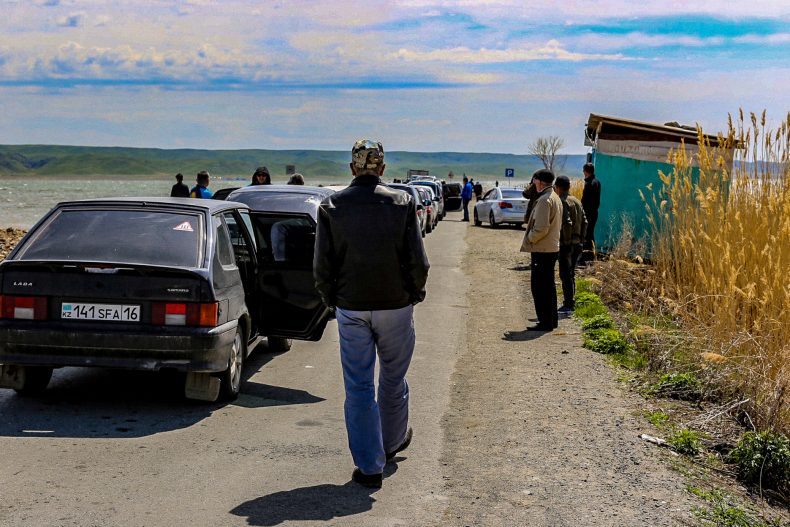
A long line of cars waits for hours. The ferry “broke” and never arrived. We continued to the south hundreds of kilometers looking for a place to cross. Photo by Nicholas Muller
Good Neighbors, Pollution Concerns
Russian Omsk and Kazakh Pavlodar are slightly over 400 kilometers away from each other – five or six hours by car. There are no direct trains between the cities and steamboat navigation along the Irtysh stopped in the 1990s. The only way is to travel by car or bus on the highway along the bank of the river.
Pavlodar residents often visit Omsk and vice-versa. Many people have families and friends living in the two cities. Some people travel for studies, others for work. Officials from both sides of the river also peacefully coexist, coordinating roadworks and a steady supply of condensed milk and vegetables as well as visiting each other in delegations to discuss crops.
The Irtysh is the only thing that sometimes clouds the peaceful relationship between Omsk and Pavlodar. The Russian city is located down the river and locals always worry about their neighbors flooding them or, on the contrary, taking all the water; but most importantly, they worry about the river’s cleanliness.
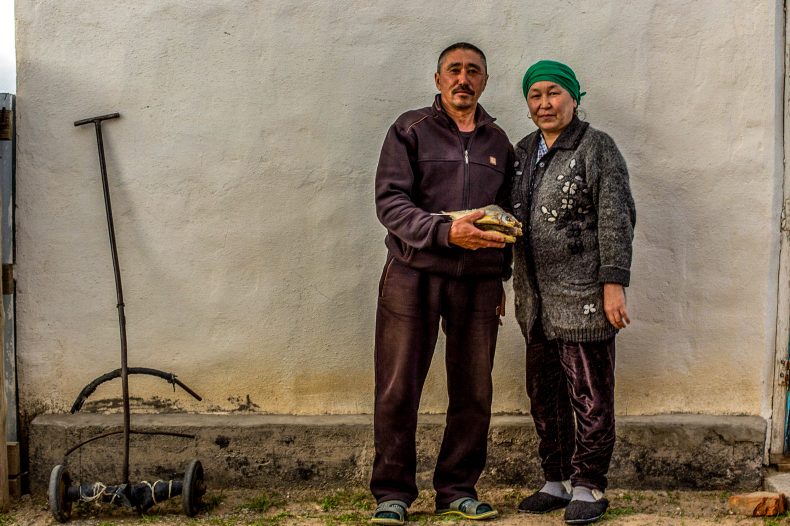
Murat and his wife with the fish they caught in Zaysan. Compared to previous years, they say fish are more scarce. Photo by Nicholas Muller
A chemical plant located in Pavlodar five kilometers away from the Irtysh produced caustic soda using mercury from 1975 to 1993. During those years, a large amount of heavy metal spilled into the soil. There are different estimates of the volume of mercury in the soil: ranging from 900 tons to 40,000 tons. Whatever the exact amount, a portion of that heavy metal entered the nearby lake of Bylkyldak together with the plant’s wastewater.
It was not until the plant shut down in 1994 that Pavlodar authorities learned about the tons of mercury systematically spilled into the soil and the lake. It was only in 1996 that the Omsk authorities learned from the media about the threat of mercury entering the river on the Pavlodar side, according to Lev Fyodorov, a Russian expert on chemical weapons and creator of the Chemical Safety Union in Russia.
“Mercury drenched the soil and started to gradually migrate to the river. In 2003-2004, they constructed the so-called 25 meter depth wall in the ground by digging a ditch and filling it with clay, hoping that it would stop the mercury,” says Omsk ecologist Kostarev.
At the Edge of Kazakhstan: Buran
Buran was once a lively Soviet town, rural but not lacking in industry. Sitting on two rivers, the Kalzhir and the Irtysh, Buran had a large collective farm raising animals and hosted a petroleum depot with a large port receiving barges of coal.
Toktubay Atykanov, 67, a native of Buran, worked on a state-owned collective farm. He says that of the village’s 800 residents, 650 are descendants of Kazakhs who fled from the Soviet authorities to China in the 20th century.
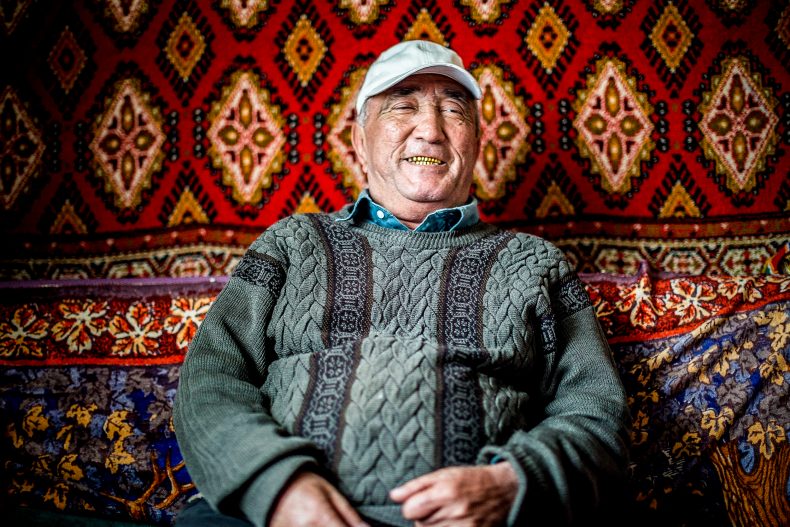
Toktubai Atykanov, 67, one of the few indigenous Buran people, was born and raised here, worked on a collective farm and a state farm. He says that of the 800 inhabitants of the village, about 650 are Uralmans. Photo by Nicholas Muller.
Ten years ago, Kazakh authorities launched a program to entice its diaspora, much of which was in China, to return to Kazakhstan. The so-called Uralmans, or returnees, mainly settled in eastern Kazakhstan. “Agriculture in Buran is impossible,” says Toktubay, “because the soil is not fertile. Only corn and sunflowers grow well. The residents fail to earn any money by fishing. The catch is barely enough for the family.”
After the collapse of the Soviet Union, the town began to decay. Companies closed and residents left for opportunities elsewhere. Locals say the port was closed and the steamship industry fell into decline.
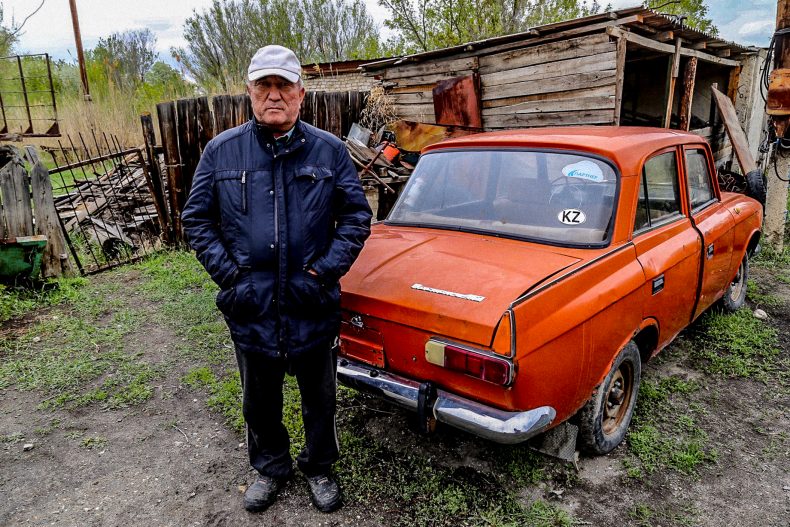
Atykanov by his Moskvichka. Buran is the last town in Kazakhstan before China and used to be a more lively place, humming with industry. Now it is virtually a ghost town. Photo by Nicholas Muller
Nowadays, it would be impossible to revive the steamship industry, according to local resident Vladimir, who has worked as a captain in the Buran port for several decades. Since China started to develop industry and agriculture in the near-border region, the Irtysh has become very shallow.
“The river changes every year,” Vladimir says, remarking that there is less water each year. China, he says, takes water to feed channels on its part of the river and has built dams as well.
“They will clean the water, sending only dirt our way. There used to be an agreement that everyone could use borderline rivers, but [Kazakh President] Nazarbayev negotiated with them: at first there was 7 percent [taken by China], then 17, and now take as much as you need. That’s the mess we are in,” says Vladimir.
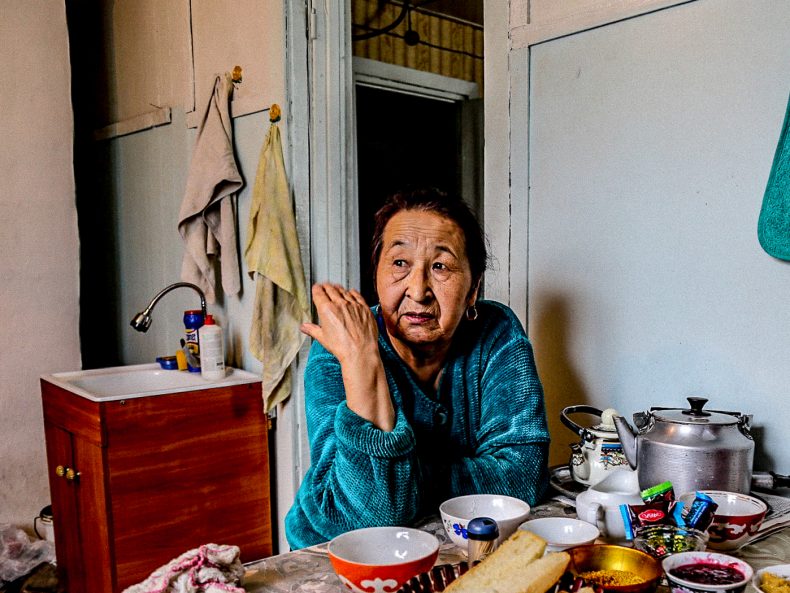
Inside the kitchen, talking about how things have changed in Buran. It still serves as a key point for measuring and regulating water levels for Kazakhstan. Photo by Nicholas Muller
Other village residents also mention that the Irtysh is growing shallow. Lyubov was born and raised in Buran; she raised six children there. She worked at a grain collecting station before it closed in the 1990s. Now retired, she mostly takes care of her garden and two cows; she waits for her seven grandchildren to visit.
“There used to be barges here, but now the river is growing shallow. They [towboats] used to come from Ust-Kamenogorsk. Every spring they clean the riverbed, but it is not as it used to be. People have become more passive now… Now we have only a post office, a hospital, a school, and a meteorological station here. There used to be a petroleum station, petroleum base, livestock, procurement agency, but now all is gone. So, as they say, we live well, but there’s nothing good about it,” says Lyubov.
The meteorological station in Buran is located on the bank of the Irtysh. A gauging station is nearby in a small one-level brick building with an addition. A chemist who works there says that his job is very simple: “I take a water sample and technical equipment makes the analysis.” The Buran gauging station checks the quality of the Irtysh water arriving from China into Kazakhstan. However, it cannot change anything.
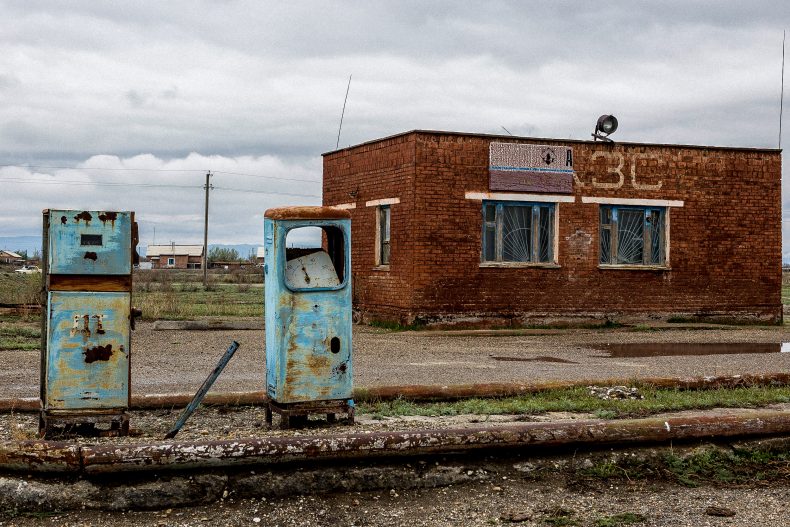
An abandoned gas station in Buran. Buran lost most of its population after the Soviet Union collapsed and people moved elsewhere. Photo by Nicholas Muller
The State of Cooperation: Three Countries, One River
China traditionally prefers to deal with water politics at a bilateral level, which allows them to be fairly conciliatory and cooperative in some cases and quite aggressive elsewhere. In terms of the Mekong and the Brahmaputra, for example, China has taken a less cooperative approach with its neighbors.
“China looks at water originating in its own territory as a purely domestic issue,” Selina Ho, from the National University of Singapore who published a paper last year on China’s transboundary cooperation, tells The Diplomat.
Although a number of international conventions on the use of transboundary water bodies have been signed, China is still very much on the sidelines.
As an upstream country, China has the upper hand to exercise substantial control of transboundary water and has constructed dams along the Irtysh, Mekong, and Brahmaputra rivers.
China continues to take an unrelenting approach to shared natural assets with its neighbors and voted against the UN Watercourses Convention, along with with Burundi and Turkey.
China is ready to discuss the matter of its activities on the upstream Irtysh and its tributaries with Kazakhstan, but not with Russia, although the effects may be felt as far down the river as Omsk in western Siberia.
The situation with China is also worsened by the fact that there are no internationally recognized and binding laws on transborder water sharing.
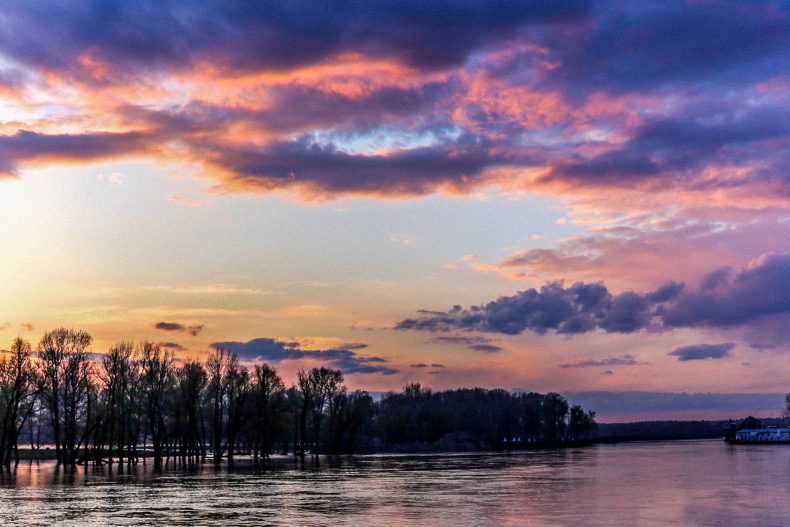
A view at sunset of the Semey portion of the Irtysh river. Photo by Nicholas Muller
For decades, Russia has floated the idea of redirecting the Katun river, a tributary of the Irtysh into Kazakhstan. For Russian ecologist Evgeny Semenov, who specializes on river systems between Russia and China, that proposal “would be disastrous.”
Sebastian Biba, a research fellow at the Institute of Political Science at Goethe University Frankfurt, Germany, concluded in a 2013 paper that “[w]hile China may not want to aggravate relations with its peripheral states too much, its long run priority is still most likely to be guaranteeing sufficient water supplies for its own people.”
Kazakhstan and China signed a cooperation agreement on the usage and protection of crossborder rivers in 2001. Both countries agreed on a list of 23 crossborder rivers. In subsequent years, additional agreements were signed.
According to Zhulduz Baizakova, a Kazakh scholar, the two largest rivers, the Ili and Irtysh, are increasingly under pressure.
Chinese withdrawals from both rivers have increased in large part due to Beijing’s state development project in Xinjiang. Given Beijing’s plans to increase the population of Xinjiang from 20 to 100 million people, it is expected that by 2030, China will increase its water intake by more than half.
Experts believe that only negotiations in a trilateral format can truly address the complex situation along the Irtysh, but as noted above China has agreed to discuss Irtysh issues only with its immediate neighbor on the river, Kazakhstan.
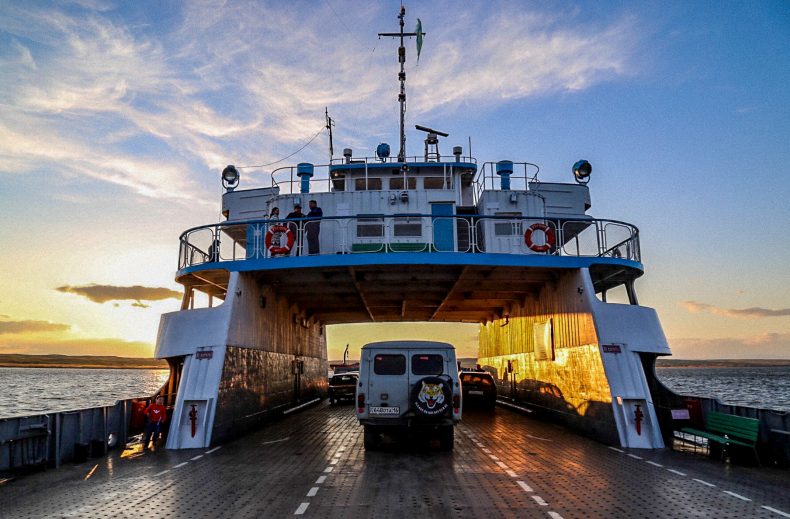
On the ferry at sunset back over the Irtysh. Photo by Nicholas Muller
Good and Bad Floods
When it floods, the Irtysh provides fields with water and allows fish to spawn in the flood lands. At the same time, hundreds of villages and garden plots go underwater.
“Watch out! Don’t step into a hole,” shouts Gulsym, pointing at a large hole in the floor. An old woman is showing her daughter the house destroyed by a flash flood. Gulsym flings her hands up in dismay. “They have barely lived one year here. Marat, my son-in-law, took a bank loan for five years to buy this house. Now he still has the loan, but no place to live anymore.”
The house is located in the Zaton area in Semeya – the official name of Semipalatinsk since 2007. The river has a dam to block floods, but on March 29, 2018, the dam was washed away by water and ice. The Shulbinskaya hydroelectric power plant discharged three times as much water into the Irtysh than usual and the river, still covered in ice, crashed downstream. The houses on the river banks were flooded within 15 minutes.
Marat was at work when his 13-year-old daughter called. She was at home with her younger brother. The girl said that the water destroyed the dam and was approaching their side of the river. Marat called a taxi immediately. When he got to the house, the water was already flooding his plot. Scared, the man grabbed his children and ran, leaving everything behind.
More than 200 houses were flooded in Semeya and the nearby villages. Zaton residents say that they received no warnings about the flood, the first of its kind in 30 years. The authorities of the Eastern Kazakhstan region said they were not informed about the emergency water discharge at the hydroelectric power plant. Not prepared for the emergency, they evacuated the affected people and began to discuss compensation.
“The Irtysh has more water than needed at the moment. People in Kazakhstan even experience overflows. Generally, water and river sources is a very changeable process… the amount of water can vary from year to year. A river is a living organism,” says Kostarev, the Omsk ecologist.
A Garden on Garbage
People living along the river’s banks face the problem of flooding every year. Sometimes there is more water, sometimes less. Due to the constant risk of flooding, some residents have found innovative ways of protecting their houses and land.
Valery Aliev lives in the city of Aksu in the Pavlodar region and is constructing a house in the Glinka district. There was a dock in the district, where ships and boats landed. Aliev’s relatives moved to Aksu in the beginning of the last century. His grandfather built a house on the bank of the Irtysh with a large land plot for a garden, but it constantly flooded, making it hard to cultivate anything.
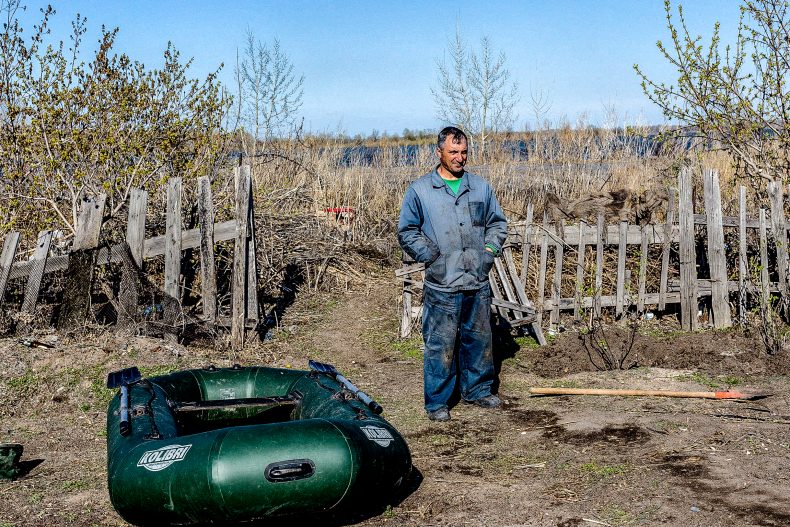
Valery Aliyev lives in the city of Aksu in the Pavlodar region. Photo by Nicholas Muller
“My grandfather worked as a driver; he transported garbage. So, he lifted the garden over the river level with the garbage and then covered it with soil. We still have garbage over there, but it will flatten out soon and we will cover it with soil, too,” says Aliev. According to him, they don’t select any specific garbage. They take whatever there is. “We have to fill it with something. We can’t take too much soil.”
The garden plot of retired Ilya Grigorievich from Pavlodarskoye village is different from others. It is the only one to survive the floods, because about 30 years ago, Grigorievich put three concrete slabs on the ground and covered them with soil.
“I was doing well working at a motor pool. They constructed a cowshed about 40 km away from here and I knew some guys at the construction site. I drove them back and forth and [entertained them] – my grandmother would cook a goose and I would buy some vodka,” says Grigorievich. As a result, the workers wrote off the inventory three concrete slabs for him, and he used them as a foundation for his garden plot. “Everything would get flooded and I needed a garden. So I took those slabs of 70-75 cm high and put soil on top of them. I built a large greenhouse there,” he recalls.
Alarmed at the situation, Omsk and Pavlodar ecologists have requested to create a committee on the Irtysh issues. In recent years, Kazakh companies have taken ownership of hydroelectric power plants and now water discharges are coordinated with local authorities and the committee of ecologists, where possible.
Nevertheless, the Irtysh waters often overflow in a way different from the previous year. At times the power plants have had to discharge water spontaneously, when water reserves overfilled. These unscheduled and unexpected discharges are the most painful for residents downriver.
“This is the force of nature,” shrug Irtysh residents who have never experienced the problem of floods. They have no idea that since the construction of the hydroelectric power plant everything that happens to the river is not a force of nature anymore, but a result of a human decision. “Who is to blame? Well, you understand everything yourself,” say the residents of the flooded houses looking at their damp walls.
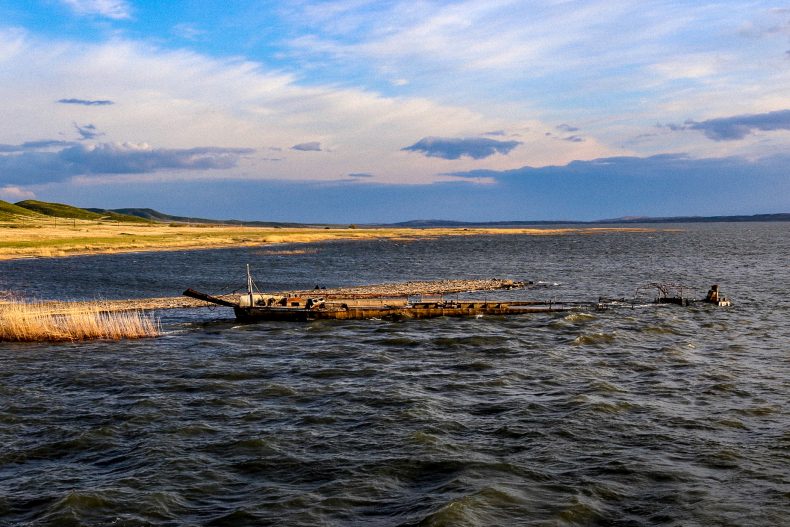
Sunken old ferry crossing back over the Irtysh from the northern portion of the river which connects to Lake Zaysan. Photo by Nicholas Muller
Nicholas Muller is an American photojournalist and writer.
Tanya Chekhova and Maya Sorova contributed to this report.

































